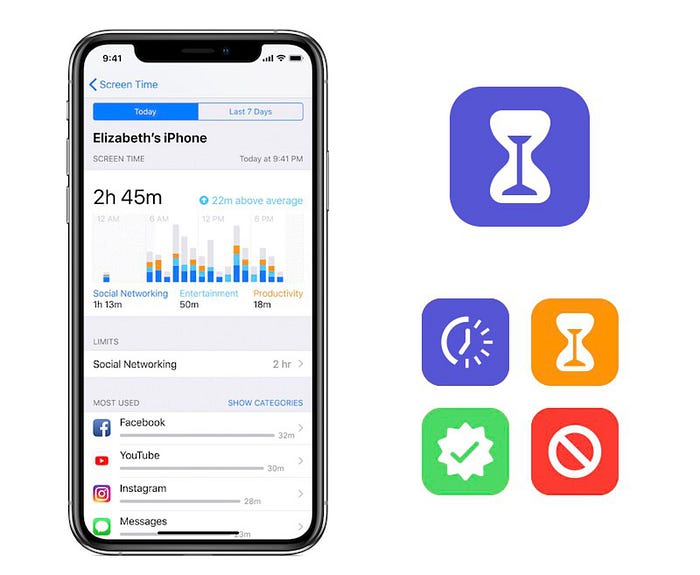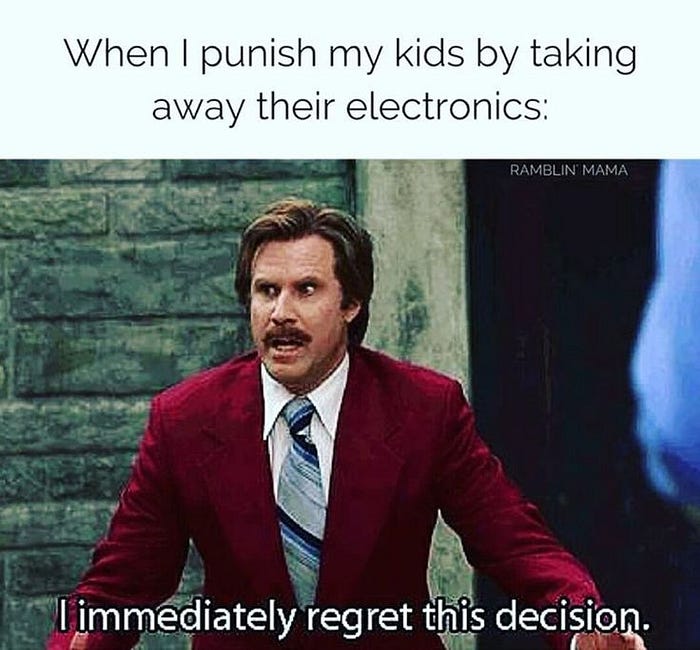Kids and their screen time: the gap between intent and action by parents

Recently, I was involved in a project whereby the goal was to make young children (4–12 years old) more aware of time spent on their iPads, and reduce it where possible. This project included qualitative and qualitative research (among others, focus groups and surveying a 100+ parents).
In case you didn’t know, kids truly love iPads. 87% of kids play on them 1–4 hours a day, and 8% plays on an iPad more than 4 hours per day! When they use the tablet, YouTube and playing games are favorite activities.
Excessive screen time often creates conflict between parent and child, as both groups have contrasting goals: kids want to have more time with their device, providing (short term) gratification in the form of fun, distraction, interacting with other kids through games, and occasionally, learning something. Parents on the other hand, aim to reduce iPad time due concerns about their children’s internet safety, mental and physical health (and rightly so).
This generates friction and leads to recurring, often unpleasant, family conversations around the kitchen sink. And so the topic of managing screen time is a hot one, especially during the Christmas holidays.
Managing Screen time
To manage their kids’ screen time, Apple’s native ScreenTime tool is popular among parents. It offers a way to lock the iPad after a certain time slot (e.g. before 9am / after 7PM) and provides insights in their children’s iPad usage. This includes things like time spent in apps, trends, etc. However, only a third of parents (30%) actively use Apple’s ScreenTime. More broadly, 52% of parents actively monitor their kids screen time, but a lot of them in a more archaic way: they take away the iPad when time is up (the good old fashioned ‘snag-a-pad’).

That being said, a whopping 95% have concerns about their kid’s iPad usage, which include excessive screen time, lack of physical activity, exposure to harmful content and reduced face-to-face social time with family members. This begs the question: why are parents not more involved in their kids’s iPad behavior, given the clear discrepancy between parents’ concerns, and the actions they take?
“..a whopping 95% have concerns about their kid’s iPad usage, which include excessive screen time, lack of physical activity, exposure to harmful content and reduced face-to-face social time with family members.”
After having researched this topic by interviewing dozens of parents and surveying many more, two things became clear to me:
- Parents do not know how to search, select and use the right tool to help them (‘I wish I knew what tools are best for my situation’)
- Parents are concerned about their kid’s device usage, but feel a lack of empowerment to take action (‘I don’t have control because I don’t know what best practices to apply’)
So, the issue is really multi-layered: not only do people feel lost choosing the right solution to manage kid’s screen time, they also feel they’re incapable of doing the ‘right thing’ from a parental perspective.
This results in two default reactions:
- reign with an iron first (‘put that thing down. Why? Because I tell you to do so!’), or
- put the head in the sand and ignore the problem altogether (‘I trust my kid to do the right thing — I don’t need put boundaries’).
Both are dangerous in their own way, and both may lead to more parent/child arguments. Moreover, reaction 2) often results in more screen time — not less, and in both cases neither child nor parent learns anything about managing screen time in a healthy way.
What could be done to improve this?
So, what can we do to give parents the right tools and make them feel more empowered? I will limit my thoughts here to digital-first solutions and observations.
There might be more fundamental parental advice and best practices to share, but I am not a psychologist nor a family therapist, so I’ll stick with ideas related to my area of expertise.

- Elevate awareness of current solutions available and their value
As many people are not aware of the tools out there to manage screen time, there is an obvious need to promote them more. Whether it’s Apple’s ScreenTime tool, Google Family, Amazon Parent Dashboard, or other 3rd party tools, organizations could educate parents more and better on the use these tools and how they contribute to kids’ health. - Make tools easy to find, install, use and manage
It’s clear from user feedback that parents cannot find the right tools, but when they do, they have trouble understanding, installing and using them. Avoid technical complexity, complex onboarding and lengthy configurations. Make it simple and intuitive. ‘Set and forget’ is the motto: make it easy to find and setup a screen time solution. Remove any barriers for parents to do the right thing. - Nudge, don’t force: promote a healthy discussion, not a toxic one
Rather than parents finding themselves in not-to-be-won discussions with their kids around their obsessive iPad behavior, we should be focusing on promoting healthy discussions between children and parents around iPad use.
For example, digital solutions could notify both parent and child about certain trends on iPad use, as a nudge to start a conversation:‘Mikey has been playing Fortnite for 4 hours non-stop today, and is spending less time in educational apps, why is that happening?’.
Even when there is a hard screen time limit and the iPad locks, the system could show relevant information about the session, or trends (’42% of kids spend less time on the iPad than Mikey, and engage in more educative apps. Try to reduce the time with 30 mins per day next week and see how Mikey responds.’).
Excessive screen time: our modern day version of cigarette smoking?
Current marketing messages of companies like Google and Apple are often shaped around the actual devices (iPhone, iPad, Google Pixel) and their features (camera, screen size, entertainment apps), but never on the dangers and risks of excessive device usage. This is, by the way, is not just a concerns for kids but for adults just as much.
Understandably so, because doing so would directly affect the bottom line of big tech. If people spend less (or no) time on their tablets, tablet sales dry up. There is no obvious incentive for these companies to try and promote reduction of screen time. However, just like we have public service announcements on cigarette packs, we could have PSAs on devices too (‘Excessive screen time is harmful for you and your loved ones’).

The tobacco industry was forced to display warning labels, maybe big tech should be too. History is never identical, but it definitely rhymes: the times when doctors promoted cigarettes seem laughable now — will we laugh in 25 years about our children’s device addictions and how poorly we managed them?
